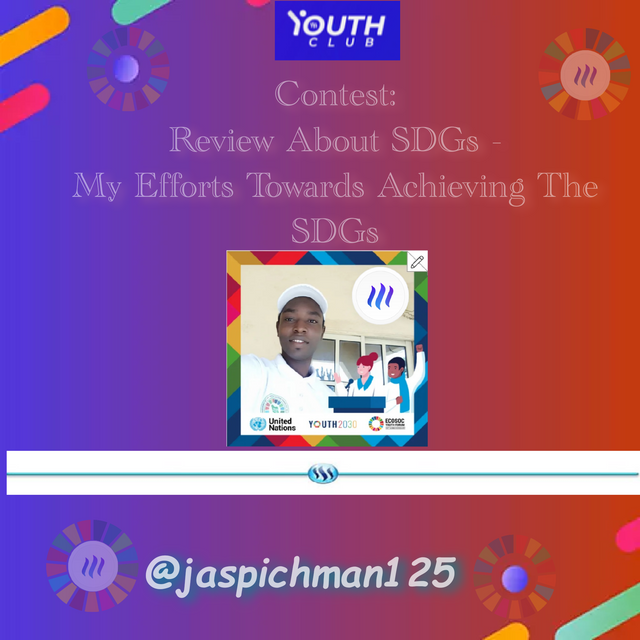
Hello fellow Steemians and SDGs ambassadors, I extremely glad to participate in this amazing contest organised by @ponpase in @youthclub community. In fact, I am grateful for joining this community because the admin and everyone here is promoting the SDGs.

Introduction
The United Nations (UN) is the world’s largest intergovernmental, intercontinental, cross-cultural, and cross-sectoral organisation that is best known for it’s policies and actions towards bettering the lives of people across the globe.
The UN has come up with several frameworks that have changed the lives of millions of people in the world. Frameworks such as the United Nations Children’s Emergency Fund (UNICEF – is responsible for providing humanitarian development services to children across the globe), the United Nations Educational, Scientific and Cultural Organization (UNESCO – seeks to build peace and harmony through international cooperation), the U – Report (a social messaging tool developed by UNICEF to accelerate international movement for positive social change), the Millennium Development Goals (MDGs – a set of 8 goals which the UN agreed to achieve by the 2015). These are few among others.

The UN member states gathered in New York on September 8th, 2000 and discussed about the prevailing challenges the world is suffering from most especially, the underdeveloped as well as the developing nations.
The outcome of the meeting was a set of 8 goals famously known as the Millennium Development Goals. One hundred and ninety one (191) UN member states and 22 organisations pledged to achieve the MDGs by the year 2015: fifteen years after the flag off.
The MDGs are: 1. Eradicate extreme poverty and hunger 2.. Achieve universal primary education. 3. Promote gender equality and empower women. 4. Reduce child mortality. 5. Improve maternal health. 6. Combating HIV/AIDs, malaria, and other diseases. 7. Ensure environmental sustainability. 8. Develop a global partnership for development.
The MDGs recorded some level of progress but largely failed due to what other critics and analysts say “centred on developing countries“. Because of this reason, the MDGs could not garner the much needed support from the relevant stakeholders .
As the year 2015 was approaching, it became clear that the MDGs either needed a successor or a restructuring.

The term Sustainable Development was popularised in the year 1983 after The UN's Brundtland Commission. The UN raised a global outcry on environmental, economic and social challenges that plagued the world.
After the MDGs failed, The UN turned their attention towards building a Sustainable world where environmental sustainability, social inclusion, and economic development are valued.
The need for the successor of MDGs was imminent, after several consultations, specialised panels, and surveys, the UN General Assembly Open Working Group (OWG) proposed a document containing 17 goals to be put forward for the General Assembly’s approval in September 2015. This document set the ground for the new SDGs and the global development agenda spanning from 2015-2030. Source
The SDGs are:
| Goal | Description |
|---|---|
| 1 | End poverty in all its forms everywhere |
| 2 | End hunger, achieve food security and improved nutrition, and promote sustainable agriculture. |
|---|---|
| 3 | End hunger, achieve food security and improved nutrition, and promote sustainable agriculture. |
| 4 | Ensure inclusive and equitable quality education and promote life-long learning opportunities for all. |
|---|---|
| 5 | Achieve gender equality and empower all women and girls. |
| 6 | Ensure availability and sustainable management of water and sanitation for all. |
|---|---|
| 7 | Ensure access to affordable, reliable, sustainable, and modern energy for all |
| 8 | Promote sustained, inclusive and sustainable economic growth, full and productive employment, and decent work for all. |
|---|---|
| 9 | Build resilient infrastructure, promote inclusive and sustainable industrialization, and foster innovation. |
| 10 | Reduce inequality within and among countries. |
|---|---|
| 11 | Make cities and human settlements inclusive, safe, resilient and sustainable. |
| 12 | Ensure sustainable consumption and production patterns. |
|---|---|
| 13 | Take urgent action to combat climate change and its impacts. |
| 14 | Conserve and sustainably use the oceans, seas, and marine resources for sustainable development. |
|---|---|
| 15 | Protect, restore and promote sustainable use of terrestrial ecosystems, sustainably manage forests, combat desertification, halt and reverse land degradation, and halt biodiversity loss. |
| 16 | Promote peaceful and inclusive societies for sustainable development, provide access to justice for all, and build effective, accountable and inclusive institutions at all levels. |
|---|---|
| 17 | Strengthen the means of implementation and revitalize the global partnership for sustainable development. |
The SDGs is an “all inclusive” concept with a popular slogan of “leave no one behind”. Unlike the MDGs which was directly or indirectly centred on developing countries, the sustainable development goals affects every single individual on the planet earth today. The rich or developed countries have challenges as well as poorer or developing countries. So, all hands must be on deck in pursuit of achieving the SDGs by the year 2030.
Actions must be taken at the local, national and international levels in order to ensure wide coverage of the goals in all areas.

How To Track The SDGs Progress
The SDGs have recorded a fairly good success since its flag off but there’s still a long way to go.
How do we track our progress then? The social progress index (SPI) is a tool or module used in measuring the social progress of nations.
The Social Progress Index (SPI) measures the extent to which countries provide for the social and environmental needs of their citizens. Fifty-four indicators in the areas of basic human needs, foundations of well-being, and opportunity to progress show the relative performance of nations. Source
Indicators or variables used in measuring the SPI
- Basic human needs:
- Nutrition and basic medicare. 2. Water and sanitation. 3. Shelter. 4. Personal safety
- Foundations of wellbeing:
- Access to knowledge. 2. Access to information and communication. 3. Health and wellness. 4. Environmental quality
- Opportunity:
- Personal rights. 2. Personal freedom and choice. 3. Inclusiveness. 4. Access to advanced education

The youths plays an important role in actualisation of the SDGs. They’re vital performers. There are over 1.8 billion youths in the world today.
The youths have qualities and capacities to accelerate the actualization of the sustainable development goals . The youths are largely interconnected worldwide through the Internet and the social media, this gives them the opportunity to form cooperations, youth activity groups, campaigns etc.
All over the world, the youths are waking up to the realisation of the importance of the UN’s SDGs. Consequently, the world has seen an increase in youth clubs or groups advocating for one or all of the SDGs. Examples of such groups include the Connected Development (CODE), a worldwide movement started by Hamzat Lawal from Nigeria. CODE is a youth civil society group that started in Nigeria but has since gained traction from across the globe, Hamzat Lawal (CEO, Connected Development) is a nominee for the Gothenburg Sustainability Award. Source
The YIAGA Africa is another non-profit civic hub of change makers committed to the promotion of democratic governance, human rights and civic engagement. It has offices in Gambia, Ghana, Liberia, Nigeria and Sierra Leone Source
The roles of youths cannot be over emphasised. The Not Too Young To Run movement which started in Nigeria led to the adoption of a Bill by the Senate to allow young Nigerians to run for any public office in the political ecosystem. The movement has gone global and gained popularity through the #NotTooYoungToRun hash tag.
The STEEM for SDGs is another groundbreaking initiative by Pon Pase (@ponpase) to bring SDGs to the Steemit social media platform. The Youth Club is also a similar initiative.

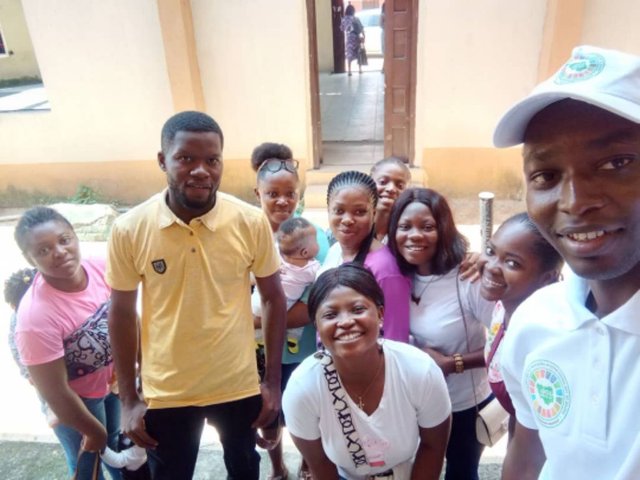
I am a member of a community development service (CDS) youth group in my country. We advocate all the sustainable development goals.
We’ve carried out campaigns on financial inclusion as a means of eradicating poverty.
We’ve also done environmental sanitation exercises.
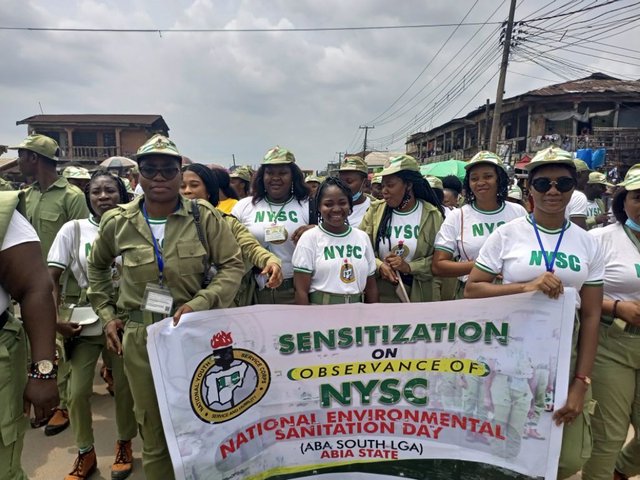
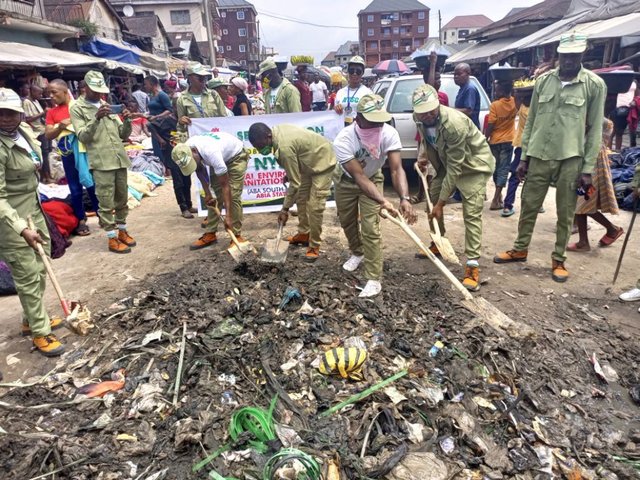
In my effort to provide quality education to children, I go to schools to teach them and also make them aware of the SDGs.
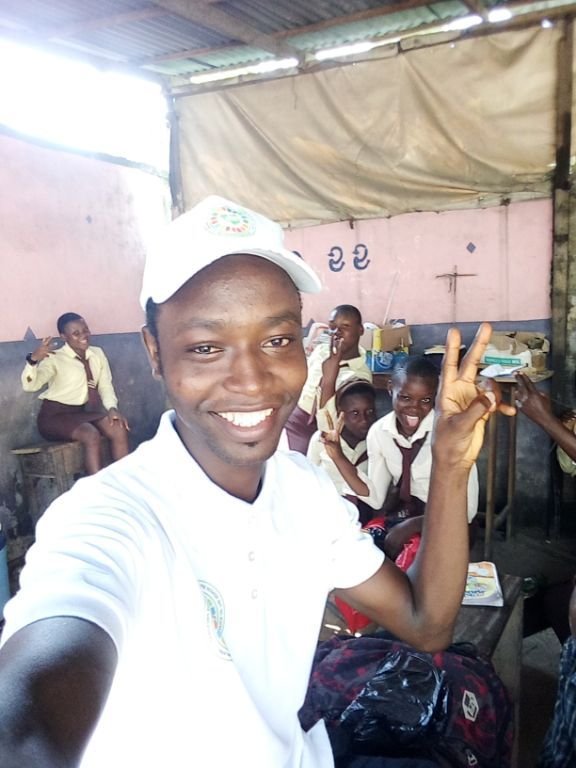
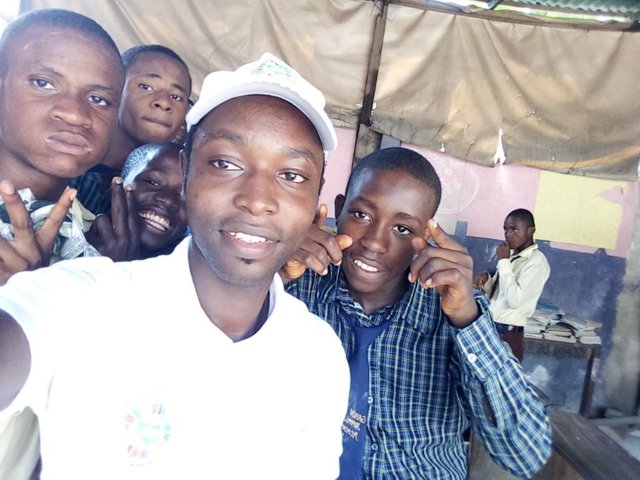 I and my students during a Selfie session after a lesson. Achieving goal-4 on quality education. Teaching young people about the SDGs at this early stage is very crucial to achieving the goals.
I and my students during a Selfie session after a lesson. Achieving goal-4 on quality education. Teaching young people about the SDGs at this early stage is very crucial to achieving the goals.
I have also participated in economic and social council youth forum (ECOSOC), organised by the UN to accelerate the actualization of the SDGs.
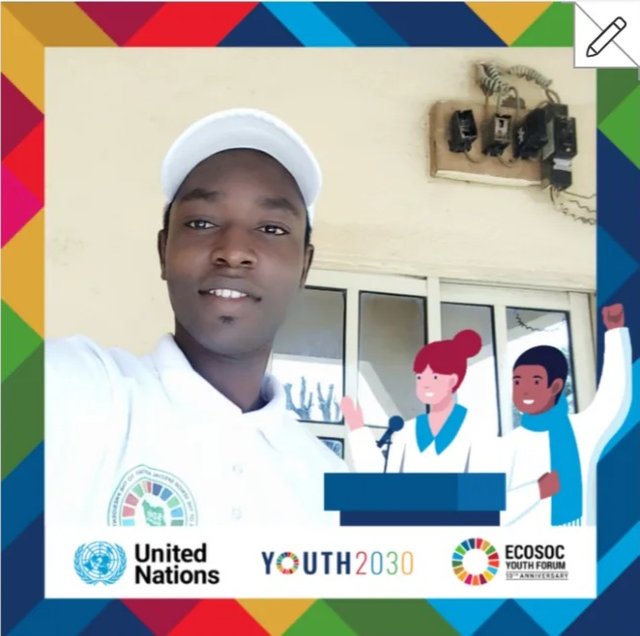
The program was about conducting dialogue among youths about challenges affecting the well-being of youths. It was held in the month of April 2021. This is the link to my ECOSOC profile/badge

Not all blockchains and their associated cryptocurrencies are equal. They’re built or designed in different ways to serve different purposes. Some consume high amount of power e.g., Bitcoin in the process of mining new coins, hundreds terawatts of electricity is being used up by hundreds of computers that possess transactions on the network called nodes. In a report published by the BBC news on 10th February 2021, Bitcoin mining consumes more energy annually than the entire country of Argentina.
This has a devastating effect on the environment. As SDGs ambassador, I personally have refrained from buying Bitcoin in a bid to cultivate an “environment centred” ideology. We have to start by doing the little things that matters. I only use Etherium, Cardano, Ripple and STEEM and a host of other low power consuming cryptocurrencies in an effort to promote climate action (fight against environmental degradation).

The SDGs is an all-inclusive universal framework which leaves no one behind. Therefore, there most be policy coherence, interdepartmental and cross-sectoral participation in order to achieve it.
Youths are by far the key players in achieving the sustainable development goals. This is because the youths are versatile, innovative, strong and full of potentials. The youths can use arts, creativity and innovation to accelerate the achievement of the sustainable development goals.
Let’s continue to promote Steemit to our friends and families because Steemit can help them come out of poverty and as a result, we’ll indirectly achieve goal-1

Special thanks to;
@ponpase
@pojan
@muhajir169
@teukumuhas
Thanks for reading my post. Hope you liked it?
Best regards; @jaspichman125
Hello @jaspicman125
Welcome to the Youthclub community, thanks for your contribution and partisipation in the contest, wish you are a winner ☺️
Regard @teukumuhas as youthclub team
Downvoting a post can decrease pending rewards and make it less visible. Common reasons:
Submit
Thanks for your kind words. I am so happy for being part of this great community.
We win 🏆 together!
Downvoting a post can decrease pending rewards and make it less visible. Common reasons:
Submit
You are welcome ☺️
Downvoting a post can decrease pending rewards and make it less visible. Common reasons:
Submit
Congratulations ! You Got Upvote by Youth Club Community.
Join Youth Club Community
Introduction Youth Club Community
Downvoting a post can decrease pending rewards and make it less visible. Common reasons:
Submit
Thanks for the support 🙏
Downvoting a post can decrease pending rewards and make it less visible. Common reasons:
Submit
Great review, thanks for participating in the contest. Hopefully more people on Steem know about the SDGs. Good Luck!!!
Downvoting a post can decrease pending rewards and make it less visible. Common reasons:
Submit
Thanks.
It is our responsibility to make the Steemians aware of the SDGs.
I'm glad we've started the movement already.
Thanks for stopping by to drop this encouraging remarks.
Best regards
Downvoting a post can decrease pending rewards and make it less visible. Common reasons:
Submit